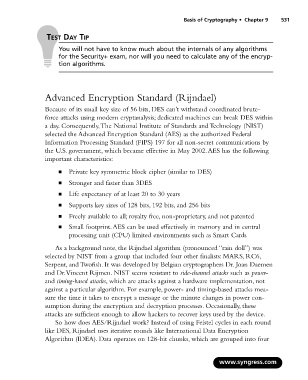Page 547 - StudyBook.pdf
P. 547
Basis of Cryptography • Chapter 9 531
TEST DAY TIP
You will not have to know much about the internals of any algorithms
for the Security+ exam, nor will you need to calculate any of the encryp-
tion algorithms.
Advanced Encryption Standard (Rijndael)
Because of its small key size of 56 bits, DES can’t withstand coordinated brute-
force attacks using modern cryptanalysis; dedicated machines can break DES within
a day. Consequently,The National Institute of Standards and Technology (NIST)
selected the Advanced Encryption Standard (AES) as the authorized Federal
Information Processing Standard (FIPS) 197 for all non-secret communications by
the U.S. government, which became effective in May 2002.AES has the following
important characteristics:
■ Private key symmetric block cipher (similar to DES)
■ Stronger and faster than 3DES
■ Life expectancy of at least 20 to 30 years
■ Supports key sizes of 128 bits, 192 bits, and 256 bits
■ Freely available to all; royalty free, non-proprietary, and not patented
■ Small footprint.AES can be used effectively in memory and in central
processing unit (CPU) limited environments such as Smart Cards
As a background note, the Rijndael algorithm (pronounced “rain doll”) was
selected by NIST from a group that included four other finalists: MARS, RC6,
Serpent, and Twofish. It was developed by Belgian cryptographers Dr. Joan Daemen
and Dr.Vincent Rijmen. NIST seems resistant to side-channel attacks such as power-
and timing-based attacks, which are attacks against a hardware implementation, not
against a particular algorithm. For example, power- and timing-based attacks mea-
sure the time it takes to encrypt a message or the minute changes in power con-
sumption during the encryption and decryption processes. Occasionally, these
attacks are sufficient enough to allow hackers to recover keys used by the device.
So how does AES/Rijndael work? Instead of using Feistel cycles in each round
like DES, Rijndael uses iterative rounds like International Data Encryption
Algorithm (IDEA). Data operates on 128-bit chunks, which are grouped into four
www.syngress.com

